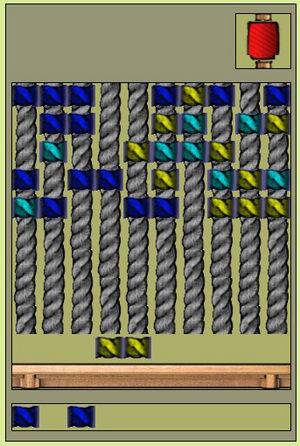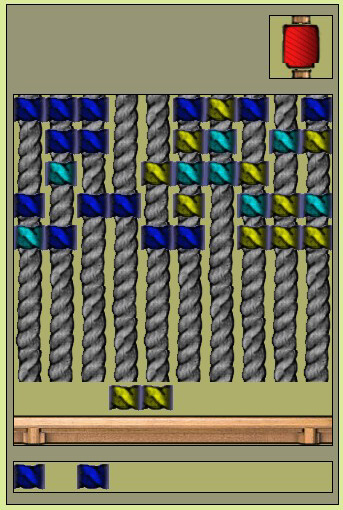GCPP:Proposal-Haddock
Puzzle Codename: Haddock
| Contact | |
| Username: | Tirix |
| Additional contact info: | On Cobalt as Rakham, PM are welcome! |
| Project forum thread: | GCPP Forum thread |
| A game gardens puzzle is available for this proposal. | |
| Play it and help as a tester! |
Game concept
A puzzle that mimicks the weaving process, by pushing threads on a weaving board.
Objective
Create predefined patterns on the weave, taking care that the waste (threads that are not used to form patterns) don't fill up the entire board.
Gameplay
Each rectangular piece is called a thread. Threads exist in different colors. The number of colors can be adjusted, the default value is 3.
Repeatedly, a set of threads is presented to the player. They are all of the same color, with possible holes in the set. The player chooses the horizontal position of the set (using the left/right arrows). In the example above, two yellow threads are proposed.
At the bottom of the screen is the beater bar. The player pushes the beater bar by pressing the space bar. The beater bar pushes all threads towards the top of the board, as long as there is space for it.
If a pattern appears, the corresponding threads are removed from the board and scored. A message is displayed depending on the move. The beater bar is then pushed forward if possible, so that combos (forming several patterns in a row in the same move) are created.
A the bottom of the game panel is a preview of the next thread set to come.
In a complete game, the player is allowed to place a certain number of threads. An unrolling spool at the top right of the puzzle panel shows how much is left.
Optionally, a timer limits the time the player has to place the thread set. If the timer expires, the beater bar is automatically pushed. This timer is symbolized by a pulling thread to the left of the screen (not shown on the picture).
An introduction to the gameplay is also available.
Scoring
A score is counted in for each pattern completed. More complex patterns will score higher. Additionally, patterns scale in the sense that any repetition of the pattern will give a higher score than just the pattern itself. One single move may complete several patterns at a time, which leads to a combo that gives an even higher score.
Variability
Special tiles (not implemented) could be added including a joker piece (the pearl) that can replace any other and give better scores, a scissor blade, that removes the threads it lands on and clears up the board, or a stone, that cannot make any pattern.
End criteria
The puzzle ends when either the player has failed to create patterns and waste fills up the entire board, or when a given number of threads has been placed. This number is choosable on the prototype, with a default value of 50.
Difficulty scaling
Bigger patterns and combos need more attention and careful planning to be completed. They also imply making waste, which is increasingly risky with the size of the targetted pattern. Different levels of difficulty can be obtained by varying the number of colors, the size of the sets of threads to place, the number of threads to place, and by de/activating the timer and choosing its value.
Crafting type
The puzzle was designed to resemble the real process of weavery.
Known problems
It is difficult to define "good" patterns for the puzzle, that are neither too simple nor too complex, and that can be planned correctly.
Notes
The puzzle has been playable in Game Gardens for months. A Game Design discussion thread also exists.
Many improvements have already been discussed. Check out the list of improvements if you are curious, it is as complete as possible.
Images
A snapshot of the Game Gardens puzzle in action:

